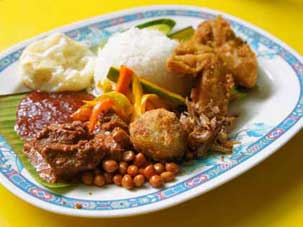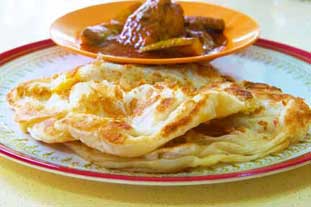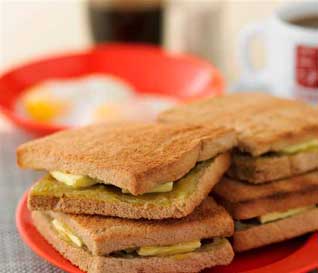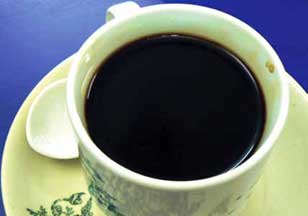Stories > Good Morning Singapore!
Good Morning Singapore!
Every breakfast tells a story. For an insight into Singapore’s cultural heritage, try these morning lessons.
By Tricia Lim
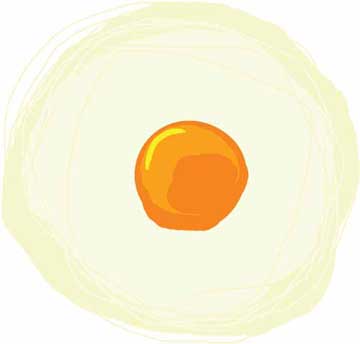 Where else in the morning can you find yourself sharing a table across from a CEO of a multinational company, tie flipped over his shoulder, slurping eggs out of a saucer? Or watch a man folding, flipping and tossing roti prata almost theatrically? Or feel on edge as a tea seller ‘pulls’ a stream of hot milky tea across empty space from one mug to another to create a warm fragrant foamy concoction that spells home?
Where else in the morning can you find yourself sharing a table across from a CEO of a multinational company, tie flipped over his shoulder, slurping eggs out of a saucer? Or watch a man folding, flipping and tossing roti prata almost theatrically? Or feel on edge as a tea seller ‘pulls’ a stream of hot milky tea across empty space from one mug to another to create a warm fragrant foamy concoction that spells home?
To anyone born here, the answer is easy – only in Singapore. Long considered a food paradise, its reputation has come not just because of its sheer variety of cuisines, but for the unique heritage that is reflected in so many of its foods.
Singapore’s food is a delicious tale of many cultures and social norms, and every local dish tells a tale through its flavours, aromas, ingredients, presentations and even names. Look closely, ask questions, taste with your eyes closed and your ears open. Breakfast is just the start.
This is a deliciously filling breakfast. Nasi is rice in Malay and lemak translates to fragrant or creamy. This Malay dish is considered the national dish of Malaysia, but has always had a place of honour in our hearts. It’s a simple and perfectly balanced composition of flavours and textures: rice cooked in coconut milk flavoured with fragrant pandan leaf and salt. Traditionally, it is served with a thin sliver of omelette, roasted red-skinned peanuts, fried ikan bilis (tiny salted anchovies) or one larger fried fish, sliced cucumber, and a dollop of sambal (a sweet spicy chilli paste). It’s best when wrapped in a banana leaf, which infuses it with a distinctive aroma.
Today, nasi lemak can be found in hawker centres everywhere. As cross-cultural exchanges would have it, there are now extended and Chinese versions of it, with add-ons such as fried chicken wings, sunny side-up eggs, fried luncheon meat and otak otak (grilled spiced fish paste). But to taste the original magic, start with the basic version for a meal that reflects the ingenuity of coastal Malay folk who combined the foods closest at hand to come up with a dish that was truly theirs.
Roti prata is unleavened dough cooked on a griddle and served with gravy, usually a mutton, fish or chicken curry. It can also be served with white sugar instead of curry for those who prefer it sweet. Originally from Chennai in South India, it was brought here by migrants more than a century ago. In the deliciously multi-lingual context of Singapore, what was simply called ‘pratha’ there is called roti prata here, ‘roti’ being bread in Malay. In Malaysia and Indonesia, it is called roti canai, the word ‘canai’ being a reference to the dish’s origins.
Foodies here and over the Causeway often argue over which version of the name is ‘correct’, just as they like to argue the ‘ownership’ of certain other favourite foods.
The plain appearance of roti prata belies its full flavour and texture, sometimes described as being like a croissant with additional ‘chew’. It’s best eaten with the fingers, tearing off pieces to dip into the curry before popping into your the mouth. When accompanied by a mug of teh tarik (pulled tea, complete with cappuccino-like foam at the top), this unpretentious and inexpensive meal transcends the mundane in a marriage of full-bodied flavours that has captured Singaporeans’ hearts as a breakfast favourite across all races.
This could be a chapter in history in itself. The concept of the sandwich — slices of buttered bread put together with a filling between — came from the British who once ruled Singapore. Fruit jams may be British too, but the locally-loved kaya is a custardy coconut spread made from eggs and coconut. Kaya, which means rich in Malay, probably has its origins in the Malay desserts in the region, but it was likely the immigrant Hainanese cooks who worked for colonial bosses who modified and popularised it as a sandwich spread by creating a sweet brown caramelised version of it just right for slathering on toast (with the requisite slabs of butter) for breakfast. There is also a green version of kaya attributed to the Peranakan (Straits-born Chinese) people of the region who use pandan leaves in their recipe.
For a ‘full works’ breakfast experience, add on a couple of soft-boiled eggs, flavoured with a dash of dark soy sauce and white pepper to be eaten from a saucer with a teaspoon.
Of course, this is not complete without the traditional inky and very strong Chinese-style coffee – and that’s another story.
The coffee in Singapore kopitiams (literally coffee shops) is unlike that found in the West. Kopitiams were started by former Chinese cooks hired by British colonials in the 1900s. In the process of trying to cook what their bosses were familiar with, while doing what they knew, they inadvertently created an entire menu of dishes which are unique to Singapore. They offered affordable yet substantial local meals to the burgeoning working class of that era, while introducing the British tea and coffee drinking obsession to the locals.
The coffee beans are locally roasted, then ground and brewed into an almost solid black nectar. To remove the grounds from the brew, an ingenious invention came about — the coffee sock filter. The comical sight of coffee-stained conical socks hanging out to dry by their metal handles behind kopitiams is a familiar one. The most traditional way to enjoy local coffee is with sinful condensed milk, although you can order it in almost any way that suits your tastebuds.
How to Order Kopi
Kopi – Coffee sweetened with condensed milk
Kopi C – Coffee with evaporated milk (The ‘C’ comes from the popular Carnation brand used)
Kopi O – Black coffee with sugar (‘O’ in dialect means black)
Kopi Kosong – Black coffee
Kopi Peng – Coffee with ice
Siu Dai – Add these words to the end of any of the above if you want it less sweet

